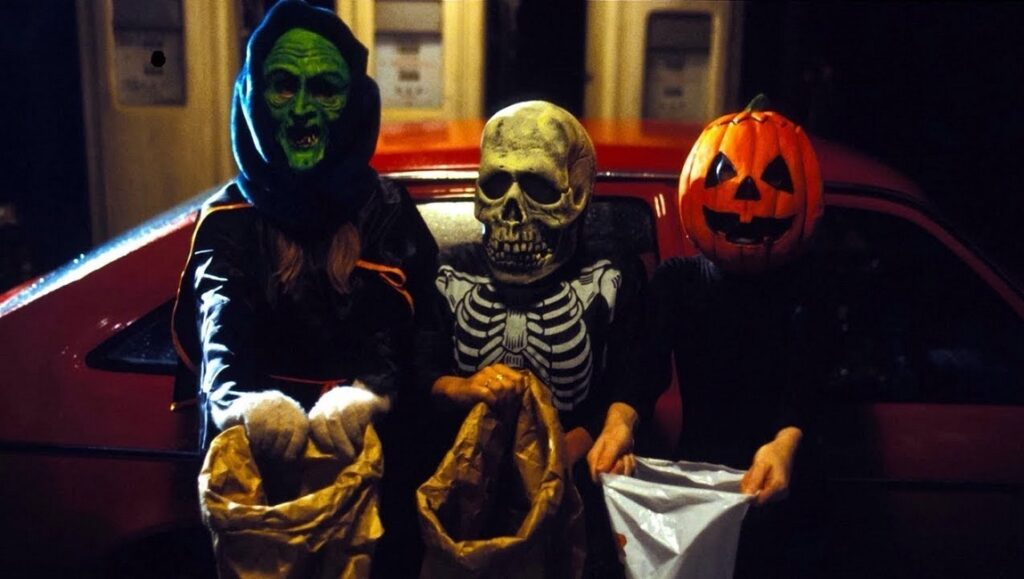“Movies don’t scare me” — said a straight-faced and stoical John Carpenter to Mick Garris in a 1982 television interview called “Fear on Film.” (Accompanying Carpenter: gregarious class clown John Landis and David Cronenberg, the latter waxing political and philosophical while Carpenter himself just seems solemn.) Movies don’t scare Carpenter, yet Carpenter’s movies are scary. Maybe that’s because it takes an unflappable filmmaker to unnerve others, or maybe it’s because, to Carpenter, horror has always been and will always be; it’s ancient and modern, irremediable like leprosy or greed. It hides in small towns, in derelict landmarks of now-crumbling megalopolises, in corporate factories whose owners will spill blood as easily as they will candy. It’s in gas stations glowing green and blue and in a forlorn arctic outpost, enfolded by brumal nothingness, populated by non-humans. It’s in the cry of a Toltetic creature hurled at us from an awful abyss. It fuels a car that kills, suffuses every dollar bill passed from hand to hand, gives life to a cipher skulking endless hospital hallways with knife and needle in hand. It scales a lighthouse, rising out of white-tip waves crenellated and coruscating under a bloated balmy sun. It can appear, humorously, as a floating eyeball-blob in the corridors of an evil Chinese sorcerer’s underground palace and, with sinister and grotesque geniality, it surreptitiously adorns Los Angeles billboards.
Carpenter is something of a recrudescent minimalist, which makes him easy to imitate (which is not to say emulate). He has a lot of shots that look like other shots of his (he loves shooting hallways, and he is the best at it). Scores sound similar, and pacing maneuvers and mannerisms and pet themes all become apparent, quickly, with Carpenter. But even if you somehow managed to avoid ever seeing a Carpenter film, you surely know what one looks and sounds like because you’ve surely seen subsequent generations of directors ape his style. Carpenter’s influence has, like some kind of other-realmly Lovecraftian entity, entered and transformed popular culture, seeped deep into the crevices and inspired many spawn, as is evident by the ubiquity of these “Carpenter-coppers” (e.g. James Wan, Leigh Whannel, Adam Wingard, etc.), who plunder liberally. But what his pupils have in aesthetic allusion they lack in artistic conviction. And comparisons to Carpenter are, at this point, largely obligatory — anything with a synthesizer or 2.35 nighttime compositions (e.g. The Void) gets automatically likened to Carpenter. This makes sense, to a point: Carpenter is as inimitable as he is oft-imitated, territory that comes with having shot almost all of his features in Super 35 and written the music for them as well, his signature sound composed for electronic keyboard devices and sometimes rock guitar. Carpenter movies look, sound, feel a certain way, jettisoning the excess and indulgence of Reagan-era egotism, an economic way of portraying iniquities. The man who can do it all — write, direct, produce, compose, act, react — always finds the right spot to place his stationary camera, the right path for his roving Steadicam to move along, the right source of light and the right amount of shadow seeping into widescreen frames — the right fusillade of synth notes. Consider those scores: The Fog, funereal, ephemeral flurries of notes adrift in seas of synths held like breath underwater, organ groans like deep-sea death knells; Halloween III, its maleficent sonic monotony of electronic blips and insidious stabs of synth patterned like microchip algorithms. But also, credit collaborator Alan Howarth (whose solo work includes the demented pop-synth score for The Dentist).

Credit: Shout! Factory
The 1980s were productive (if not always pleasant) for Carpenter, who, riding high after Halloween, began the decade with The Fog, a ghost story whose deep-seeping dread harkens to Lovecraft, James, Machen, Bierce, Blackwood, et al — a classic tale made modern, the past ebbing, coming back again. The film opens with a campfire tale most ghoulish, told by John Houseman, followed by a sequence of subtly unsettling shots of a miscellany of mundane objects — convenience store fridge, clocks, chairs, car alarms, and so much shattering glass — behaving oddly. A sodden priest (the late Hal Holbrook) finds, interred in the stone of his church office, the diary of his great-grandfather, divulging a terrible truth. The Fog‘s vengeful wraiths, murdered for their malady (and their gold) by men ostensibly holy, rise from watery graves to make a small town built on blood pay for the sins of their fathers. The film was shot just north of the redwoods and sequoia looming portentously above San Francisco, in historic Port Reyes (here called Antonio Bay), which is statistically the foggiest town in the United States. Verdant crescents of rollicking hillocks and knolls and sinuous-swaying grass are enfolded by the bluest bay, crenellations waving whitely towards the jetty, the shore, land; a perilous-looking walkway hung above frothing waves and the rocks below; bucolic, banal, a beautiful and boring small town of seemingly just a handful who, like characters from a Hawks western, find themselves under siege.
Halloween II, produced and written, reluctantly, by Hill and Carpenter (who wrote the thing in a beer-blitz of balderdash acrimony), looks, at times, like a Carpenter film, with Dean Cundey’s aseptic lights and chilly blues imbuing familiar hospital hallways, autumnal oranges lambent from fluttering candle flames, and those Steadi shots gliding through caliginous neighborhoods like a shark prowling shallow water. It even sounds like the O-G Halloween, with Carpenter lacing the infernal, ubiquitous score with a more gothic, scar-tissue-thick tone. But the film, which notably relishes in gore whereas Carpenter’s seminal slasher had eloquent restraint, features stabbings and slittings and a hot naked nurse boiled face-first in a hot tub; it doesn’t have the economy, the feeling, the genuine stuff that defined the original. Michael Myers here moves with a mechanical rigor rather than with the unnatural, tireless torpor of Halloween. The inferno ending was meant to bring an end to Michael Meyers, but all it did was ban him to an eternity of Sisyphean diminishment.
Carpenter has had a lot of creative consorts in his career, notably Dean Cundey and Gary B. Kibbe, his main cinematographers, Nick Castle, character actors Charles Cyphers and Dan Atkins and Peter Jason, producer Larry Franco, and, of course, producer and writer Debra Hill. But for my money, Carpenter’s most interesting collaborator and the truest student of his craft was Tommy Lee Wallace, who worked in various capacities (editing, sound effects, production design, etc.) on several Carpenter films, and was chosen to direct the third Halloween film (after rejecting an offer to helm the second). Halloween III: Season of the Witch, the strangest and best of the many progeny born of its progenitor’s immense influence, is, at once, a beguiling, masterful master’s copy of Carpenter, faithful to the spirit as well as the aesthetic, while also playing with editing more than Carpenter had in his film, and composing a shot of a television set on film as well as any name-brand auteur ever has. The film was intended as a reboot for the Halloween series, one which would cast it as an anthology where each subsequent installment would tell a new un- or semi-related Halloween tale. Here, that tale concerns an eccentric and iniquitous Irish owner of a toy manufacturing company whose stratagem for the ultimate Halloween prank is to kill all the kids using advertising. He wants to inveigle parents into purchasing rubber masks for their kids, and then, after much merchandizing and advertising and word-of-mouth hype among the adolescent and adult alike, playing a stroboscopic commercial, accompanied by the catchiest goddamn jingle, turn the kids into writhing piles of bugs and snakes. Why? For a lark.
Season of the Witch feels like a Carpenter film; it doesn’t just look and sound like one. It has a nasty sense of humor, an anti-corporate and -commercial streak, memorable murders by man, machine, and metaphysical mumbo-jumbo. It’s awesome. All-star supporting actor Tom Atkins plays the doctor who becomes enmeshed in the conspiracy, and he gets at least three great moments: while having sex with a much younger woman (whose father he saw murdered by a robot), a death shriek from the next room causes him to spit out, with bravado timing, “Who cares?”; when he punches a robot man in the stomach and then removes his fist, which is covered in goo, and gazes at his own oleaginous appendage in befuddlement; and at the end — maybe the best end for any film Carpenter has been involved with — when Atkins screams at the television producer to “Turn it off! Turn it off!” Even though Carpenter didn’t direct Halloween III — no one should take that achievement from Wallace — the film still seems to stand, in retrospect, as the central and centrifugal, even metaphorical, center of his work. It connects to Carpenter’s Dadaistic beefcake brawler and anti-capitalist romper They Live, and to an anti-corporate streak running through Black Moon Rising, which stars a jet-black-haired Tommy Lee Jones and was written by Carpenter. Another reason that Season of the Witch is so inextricable from Carpenter’s directorial efforts? Carpenter himself served as the film’s invaluable composer — it’s to his jingle, set insidiously to the tune of “London Bridge is Falling Down,” that much horror traces back.

Credit: Dino De Laurentiis Company/Universal Pictures
Carpenter’s 1983 killer car flick Christine is notable for being the most spiritually faithful adaptation of a Stephen King work — faithful, too, to King’s soap opera anxieties, while retaining Carpenter’s own distinct voice. It’s a work of triumphant craftsmanship, as well as artistry: If The Thing is the apogee of Lovecraftian otherness and films concerned with the grandeur of the grotesque, Christine is the apogee of ‘80s-nostalgia-for-the-’50s horror; a nightmarish version of Grease. The film opens with the titular 1958 Plymouth being manufactured, while anachronistically, George Thorogood’s “Bad to the Bone” plays, 20-something years too soon. Every shot is postcard pretty, the rhythm of the car moving along the assembly line — then the hood slams shut and cuts off the music, along with a guy’s hand. Shortly thereafter, a man ashes his cigar on the car; he’s soon found dead, cigar smoldering between lifeless lips. Later, now in 1978, a bully — a slobbering, hair-greased dickhead in a tight black tee tucked into blue denim, tiny sleeves tightly hugging thickly-muscled arms — levels threats (“You fucking liar,” “I’ll knock you through the fucking wall, fuck,” “I’ll fix you!”) while skewering a yogurt with a switchblade and celebrating expulsion from school with crushed cans of American beer and nighttime drives in his engine-chugging car. In his orbit are the smart-and-pretty new girl, the likeable jock best friend, and the puritanical parental units. Soon, of course, comes the transformation — the corruption of the self, a melding of man and machine.
Christine was shot not by Dean Cundey but Donald M. Morgan, who gets that car to shine and the look of furious passion in Arnie’s eye to glint. Like many of Carpenter’s characters, Arnie (Keith Gordon) doesn’t, as slovenly junkyard lord Darnell (the great Robert Prosky) puts it, got money falling out of his asshole. He is corrupted by a car, that familiar sign of teenage emancipation, a symbol of adulthood and independence — yet Arnie becomes beholden to his car, possessed by its evil spirit. Even with King’s usual tinny dialogue to contend with, Christine manages to be more in-tune with what makes people people, with our motivations and obsessions and fears and fatal flaws, than Starman, Carpenter’s obligatory studio mediocrity, in which alien Jeff Bridges learns his humanity in piecemeal, instead of by being turned into a car.

Credit: Columbia Pictures
Arnie spends his college savings ($250) on Christine and works in a place for workin’ stiffs who gotta keep bread on the table. Penury is often perilous in Carpenter’s work. Consider the swarm of homeless who encircle the church in Prince of Darkness, using detritus to threaten un-moneyed monsters susceptible to the allure of the Devil. In They Live, a peripatetic construction worker stumbles upon an insidious stratagem concerning ugly aliens using marketing and media to induce mass mind control over capitalist denizens ambling about life in semi-blissful ignorance. Some of these piteous poor decide to take the money and join the aliens in perpetuating subliminal oppression, but it’s still a no-named, flannel-wearing worker who ultimately saves humanity. The case is similar in Escape From New York, where the island of Manhattan — which we know as that bastion of Liberal heart-bleed that’s chockablock with almost as many wealthy people as there are poor ones, but has here become so rife with amorality and scoundrelism that the government has opted to turn the entire place into a maximum security prison, leaving criminals to erect a new oligarchy — may not be so different from the one that we know. Snake Plissken (Kurt Russell) is, despite his seething contempt for American government, sent into the squalid ruins of Manhattan to rescue the President (Donald Pleasence); he goes in one way or the other, and being the expendable pawn of the police, it affords him a chance at freedom.
Consider the masculine braggadocio in alpha males like Snake Plissken and Nada (one a vet, the other representative of what Jonathan Lethem called prolat rage), and the phony heroics of Kurt Russell’s Jack Burton in The Thing — a sidekick under the assumption that he is the hero of the story into which he’s stumbled. Carpenter’s most cynical film, The Thing was, as everyone knows, for a short time considered to be a disappointment — although tales of its status as a “failure” are sensationally simple-minded and not even very true — but is now ranked at the top of Carpenter’s filmography, according to the cinephilia metric of the day, Letterboxd. It remains a nasty work, in every sense: those misshapen pseudo-people, malformed manipulations of tissue to resemble us, horrible, oily, ugly, awful accretions of cells, but also spiritually, nastiness deeper than flesh. At some point during the last scene, I came to the conclusion that humanity is fucked because, as we know from earlier in the film, it only takes one cell to make a Thing (they even prepare their own meals from cans). Kurt Russell, disquietly calm in the bitter cold, hands Keith David a bottle of booze for them to share, and smiles subtly as he takes a sip.







